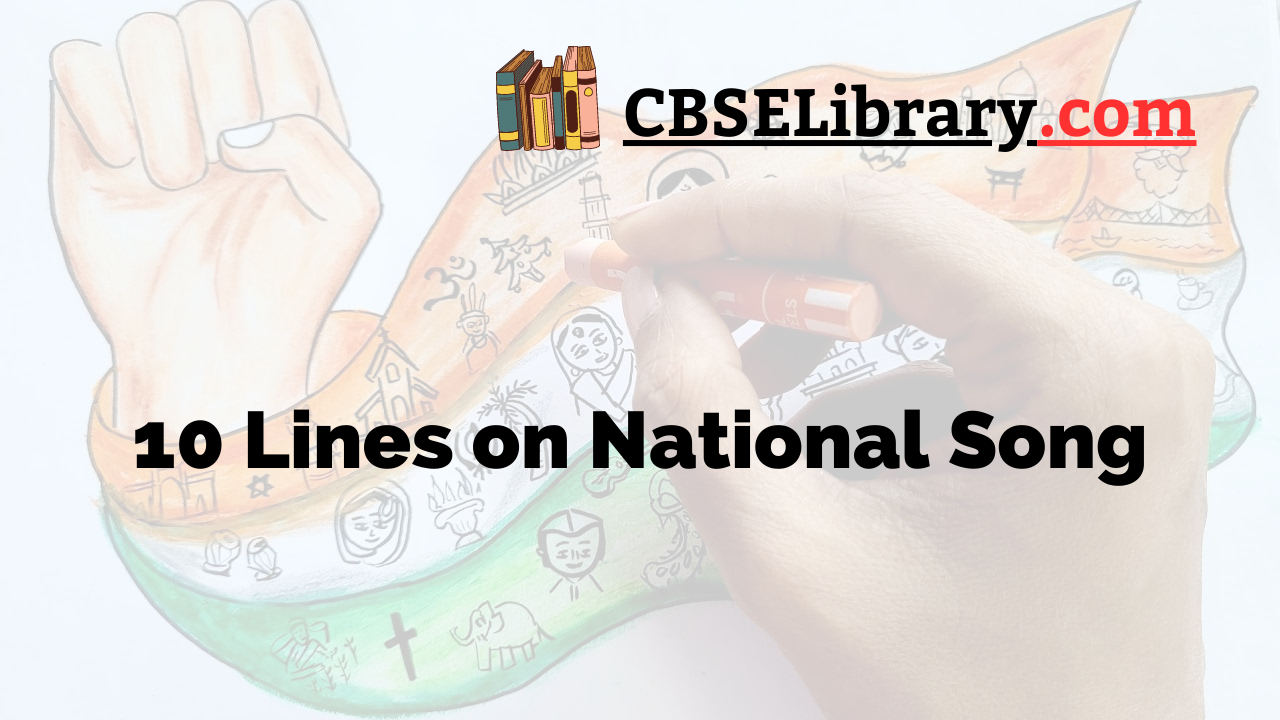10 Lines on National Song: The National song is an inspiring song about the freedom fighters of the country. It is a compelling song that inspires and instigates the feeling of patriotism in every Indian. The song was written by Bengali poem written by Bankim Chandra Chattopadhyay in 1870 and was sung for the first time by the Rabindranath Tagore in 1896 at a political meeting of Indian National Congress.
The song ‘Vande Mataram’ is recognized as the official national song by the Government of India. The National song is played or sung on special occasions of national events. The two most embracing stanzas from the song have been declared as the National Song of India after the independence of India in 1950.
We have provided ten lines on National Song in English, to aid you in paragraph writings and essays on this topic as well to assist you during competitive exams and G.K. quizzes.
You can read more 10 Lines about articles, events, people, sports, technology many more.
Set 1 – 10 Lines on National Song for Kids
Set 1 is helpful for students of Classes 1, 2, 3, 4 and 5.
- The National song is originally a Bengali poem written by Bankim Chandra Chattopadhyay in the year 1870.
- The original “Vande Mataram” poem is a collection of six total stanzas.
- The original poem was written in Bengali as ‘Bande Mataram’ and later was composed into a song by Rabindranath Tagore.
- The song was sung as a hymn to Devi Durga, as the national personification of India.
- The National song is usually sung by Indians that evoke the history of India’s struggle for freedom.
- The song played a vital role during the pre-Independence time in motivating the Freedom fighters.
- The National song shares the same status and importance as the National anthem except for a few official commemorations.
- The national song ‘Vande Mataram’ gained more popularity than the National anthem ‘Jan Gana Mana.’
- The National Song was originally written in Sanskrit and Bengali.
- The poem/song was selected as the Republic of India’s official national song on January 24, 1950.

Set 2 – 10 Lines on National Song for School Students
Set 2 is helpful for students of Classes 6, 7 and 8.
- The National Song ‘Vande Mataram’ has played a significant role in creating sparks of nationalism and patriotism among every citizen of India.
- The terms “Vande Mataram” is originally a Sanskrit word meaning ‘huge respect to mother India.’
- The National song symbolizes unity and spreads the message of harmony and peace.
- The National song has been sung or played by various famous artists at several regional and national events.
- The National song ‘Vande Mataram’ is considered a symbol of unity, patriotism, and nationalism.
- The song helped in channelizing the Swadeshi movement against the British Empire in the year 1905.
- The National song ‘Vande Mataram’ has been translated into multiple languages, namely Hindi, Tamil, Kannada, Marathi, Telugu, Gujarati, etc.
- The National song ‘Vande Mataram’ song has inspired many prominent music artists like A.R. Rahman, Lata Mangeshkar, and Ravi Shankar, who have composed different versions of the song.
- The famous Film-maker Heera Lal Sen in the year 1905 made a film that recited Indian National Song.
- The first version of the Indian Flag created by Bhikaji Cama in 1907 had Vande Mataram.
Set 3 – 10 Lines on National Song for Higher Class Students
Set 3 is helpful for students of Classes 9, 10, 11, 12 and Competitive Exams.
- The National song ‘Vande Mataram’ was written in Bengali and Sanskrit by Bankim Chandra Chatterjee in 1870.
- The National song was first sung by Rabindranath Tagore at the Indian National Congress policy meet in the year 1896.
- Inspired by the National song, Aurobindo Ghosh started the famous newspaper called ‘Bande Mataram’ in 1905.
- The famous nationalist leader Aurobindo Ghosh termed the National song ‘Bande Mataram’ as ‘Anthem of Bengal.’
- The English version of the National song was created with the title ‘I bow to thee, Mother.’
- The national song was first published as a poem in the Bengali fiction novel ‘Anandamath’ by poet Bankim Chandra Chattopadhyay in 1881.
- The term ‘Vande Mataram’ was shouted as a slogan during the Swadeshi Movement in 1910 to instill the sense of patriotic sentiments of Indian revolutionaries and nationalist leaders.
- Many Freedom fighters were sent to custody by the British because they defied the order and sang Vande Mataram at public places.
- BBC conducted a survey across the world, which resulted in the “Vande Mataram” ranking as the 2nd highest popular song in the world.
- The National song ‘Vande Mataram’ is a song to pay homage and tribute to the sacrifices of countless martyrs, who dedicated their lives for India’s freedom.

FAQ’s on 10 Lines on National Song
Question 1.
Who wrote the National Song?
Answer:
The National song ‘Vande Mataram’ was written in Bengali and Sanskrit as a poem by Bankim Chandra Chatterjee in 1870.
Question 2.
Who composed the song ‘Vande Mataram’?
Answer:
The National song was composed and sung by Rabindranath Tagore at the Indian National Congress policy meet in the year 1896.
Question 3.
What does the National song signify?
Answer:
The National song signifies the sacrifices of countless martyrs, who dedicated their lives for India’s freedom.
Question 4.
How many languages has the song been translated?
Answer:
The National song ‘Vande Mataram’ has been translated into multiple languages, namely Hindi, Tamil, Kannada, Marathi, Telugu, Gujarati, etc.
